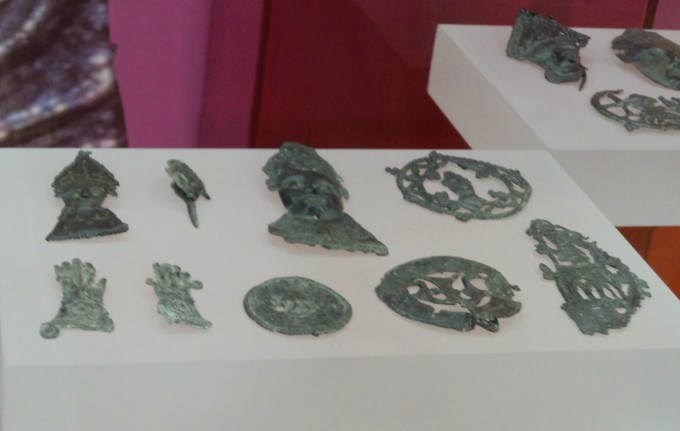To a degree this follows on from last time in that again there is a maritime theme to this short blog. Firstly, although I wasn’t able to attend this year, I have a brief report from Dr Martin Watts about Whitstable Harbour Day, which took place last Saturday. As an ex-merchant seaman, Martin is keen to promote all things nautical and, as he says, it was another excellent day.
“As the academic partner with Whitstable Maritime, who now run the annual Harbour day, Martin attended on Saturday and enjoyed, for the second year in succession, a very successful day. Visitors were again well in excess of 5,000, aided by the weather and an increase in activities open to the public. Martin, with the CCCU exhibits, were located in the main Whitstable Maritime tent, alongside a display from the Canterbury Cathedral Archives. During the day, he discussed the archival material with around 40 visitors, and answered queries on courses available at CCCU in September from a further 20. The tent also contained a display showing Whitstable Maritime’s progress with the restoration of the ‘Gamecock’, a locally built Oyster Yawl, and now a registered historic ship.”
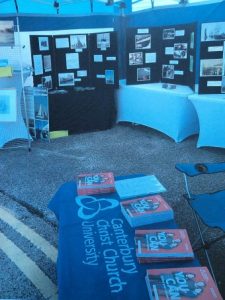
CCCU at Whitstable Harbour Day (photo Martin Watts)
Secondly, and again from Martin, is a report on his day filming at Richborough for a programme that is part of Channel 4’s ‘Britain at Low Tide’ series, which is expected to be screened in early 2019. “On Tuesday 7th August, Dr Martin Watts, together with Dr Andrew Richardson from Canterbury Archaeological Trust, attended the remains of Richborough Port (the secret port of the First World War), with a TV crew from Tern TV, working for Channel 4. Martin and Andrew were interviewed at length by the producers, discussing the archaeology and history of the port, and its innovative contribution to victory in 1918. This included the first large scale operation of Roll Ro Roll Off ferries, which were capable of receiving drive on trains and motor transport, loaded with men and equipment bound for Calais and Dunkirk. The turn round time for each trip was an astonishing twenty minutes, marking a revolution in inter-modal transportation. Barge building was also undertaken at Richborough, the barges being towed across the Channel to enter the inland waterway system of France. To sustain this activity Richborough Port became a small town of some 20,000 persons, completely self-contained with its own infrastructure, including power station, hospital and sewage farm, with a short railway link to the main line.”
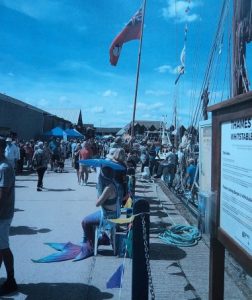
Whitstable Harbour Day – very popular event (photo Martin Watts)
Keeping with the coastal theme, on Tuesday I had a meeting with Stuart Bligh (Royal Museums, Greenwich) and Dr Elizabeth Edwards (Kent Archaeological Society) to construct a potential table of contents for the ‘Maritime Kent through the Ages’ book now that we have a better idea of how it might work thematically after the June conference. We were also able to build in feedback from the conference. For example, the very favorable response to Dr Christopher Young’s (Geography department at CCCU) opening lecture in which he discussed the changing coastline from the last Ice Age to the present day. Other changes to our earlier proposals are to combine ‘trade and industry’ within a single theme, although the modern period will hopefully have two essays that will address different issues and coastal areas of Kent; and to introduce a further chronological period – Roman/Anglo-Saxon, to some thematic sections, such as defence, where this will be especially valuable for the reader. Finally, we will have about six case studies in order to showcase certain topics or coastal communities and the richness of the Kent archival sources. I’ll keep you posted about developments, and the first step is to contact potential contributors about our proposed timetable.
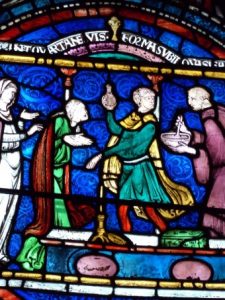
Becket window – a monk mixing the ‘St Thomas water’
Finally, for this short post, I want to report that also on Tuesday Dr Diane Heath and I met two people from Channel 4 about the programme on ‘Plantagenet Canterbury’ that will be filmed in Canterbury early next month as part of their ‘Historic Cities’ second series. Without giving anything away, they team will be focusing on both the cathedral and the city. One way of doing this is through Becket and pilgrimage because this drew together (most of the time) the archbishop, prior and monks, and the bailiffs, later the mayor, jurats and aldermen and townspeople. Such an approach might look at some of the characters involved in Canterbury’s history from the time of Henry II to the deposition of Richard II by his cousin, who became Henry IV, against various architectural backdrops, including Becket miracle stories in the cathedral’s stained glass windows, the pilgrim hospital at Eastbridge and the great Westgate Towers, commissioned by Archbishop Sudbury, who met an untimely end during the English Rising of 1381 (Peasants’ Revolt), and who is buried (most of him – his head may be at Sudbury in Suffolk) in the cathedral.
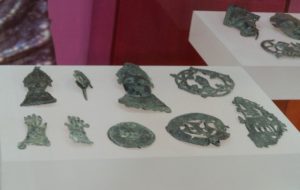
Becket badges – as they were displayed in the Canterbury Heritage Museum.
Of course, when you talk about Becket, pilgrimage and Canterbury, the other person who springs to mind is Geoffrey Chaucer and his Canterbury Tales. We did discuss this briefly on Tuesday and I think it is likely he will be included in the programme, and perhaps also details from the ‘Prologue’ in The Tale of Beryn, said to have been composed in the early 15th century by a Canterbury monk where he ensured the ‘pilgrims’ did arrive in Canterbury. There they stayed at Christ Church Priory’s great inn of ‘The Cheker of Hope’ (one of several priory inns), visited the cathedral where they looked at the stained glass windows, went to the shrine and bought ‘Cauntirbury brochis’ (except the miller and his accomplice the pardoner who steal them). While in the city the knight toured the sights, especially the city’s defences, but the wife of Bath and the prioress preferred to spend time in the inn’s well-cultivated garden. Even though ‘The Cheker’ was severely damaged in a fire in the mid-19th century, some of the medieval structure remains and the sheer size of the place can be grasped by just walking down Mercery Lane. Consequently, the team from Channel 4 have lots of choice regarding themes and approaches and it will be interesting to see what angle they decide to take. When I hear more, I’ll let you know.
 Centre for Kent History and Heritage
Centre for Kent History and Heritage Sheila Sweetinburgh
Sheila Sweetinburgh 1204
1204